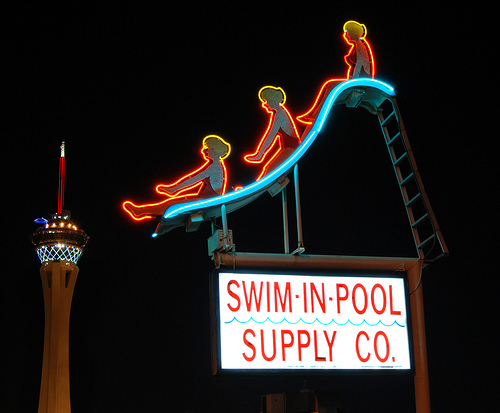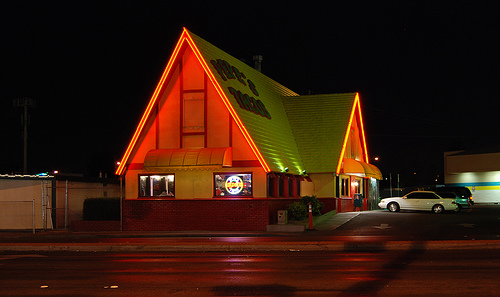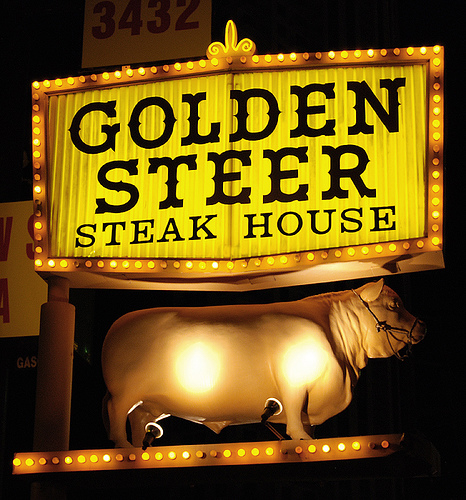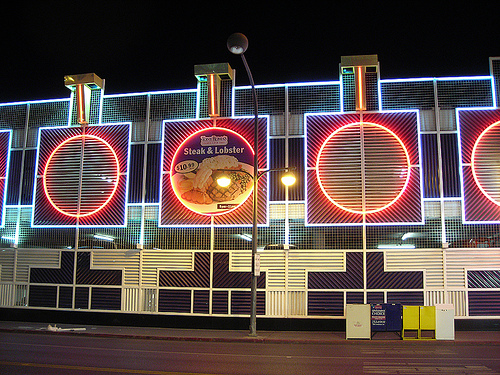Entries in Preservation Issues (114)
Dennis McBride talks Las Vegas History and More!
Looking for info on the upcoming Las Vegas High School program? Click here
Aside from being one of the early inspirations for the Classic Las Vegas Historic Collection, Dennis McBride is one of the leading authorities on the history of Southern Nevada, especially the history of the building of Boulder (Hoover) Dam and Boulder City.
He has spent his life collecting stories and memories of Southern Nevada in the 20th Century. As a native Nevadan, he has had a front row seat to the changing landscape of the Valley over the course of his life.
He is the Curator of History at the Nevada State Museum in Lorenzi Park and he was kind enough to share his thoughts on the history he has collected and much more:
As a native of Southern Nevada, how has Las Vegas changed since you were younger? How do you feel about the changes.
A Conversation with Alan Hess
As readers here know, Alan Hess is the go-to guy for Mid-Century Modern architecture and the automobile culture that surrounded it. He was one of the guests at our Salute to Walter Zick last fall. In addition to being the go-to guy, he is an author of a variety of work on the various aspects of the era. From "Googie" his look at the coffee shop and diners to "Palm Springs Weekend" celebrating the joys of that Mid-Mod mecca to "The Ranch House". But for Las Vegas Mid-Mod fans, we all love "Viva Las Vegas: After Hours Architecture". If you haven't read this book yet, get thee to the library or better yet, his website.
I talked with Alan a few days ago about Mid-Mod and Las Vegas:
What is mid-century modern architecture and why is it important? After World War II, America found itself on the threshold of a promising future. After the Great Depression, people finally had money and jobs. New technologies offered amazing possibilities: television, automatic transmissions, washing machines in your home – all brought a new, easier way of life. Mid-century Modern architecture mirrored those changes. It created new shapes and used new materials (such as steel, glass, plastic, and concrete) to give people a sense that they were living in a new era. What is roadside architecture? Why was neon so important to Fremont Street and the Strip? The automobile made the twentieth century unique. Cities grew in size because of it. People suddenly had great personal mobility. And the American city took on a new shape in response to these changes. A key element of these changes was a new kind of architecture suited to the car. Drive-in markets, drive-in movies, drive-in restaurants, drive-in banks, gas stations, car washes, and many other types of buildings along the roadside served the way people were living now that they had cars. A big part of this architecture was signage, and neon (a new technology in the 1920s) proved ideal in creating large, vivid signs that could be seen from blocks away. Beginning in the 1930s, Fremont St. became one of the most innovators for neon signs, and neon urbanism, in the nation. This exploration continued on the Strip in the 1950s. Which classic Las Vegas neon sign do you miss the most? Favorite classic Las Vegas casino/hotel? The pinnacle of Las Vegas neon was reached in the 1960s. Those signs are mostly gone now, but they remain one of the highpoints of American art. The Dunes, the Aladdin, the Stardust, the Frontier, the Riviera, the Sahara were all great. The Stardust was one of my favorites, with a scintillating cloud of light, as if falling from the heavens. The Aladdin was a true and original phantasmagoria, evoking veils, jewels, and a Thousand and One Nights. I have the fondest memories of the Dunes because of the shear power of its animation, shooting light into the night sky like a rocket, but completely silently. You did a lot of research for your book, "Viva Las Vegas: After-Hours Architecture." What was some of the information that surprised you? Will there be an updated version of the book? Most of the information in the book was a surprise to me. I had questions about who had designed these hotels and signs since reading Learning From Las Vegas by Venturi, Scott Brown and Izenour in 1975. Who had designed these buildings? Which came first? How did they evolve, and influence each other? Where did they come from? The most illuminating fact was that most of the original architects, who set the standards and models, were from Los Angeles, and had honed their startlingly new conception of auto Modernism while designing the drive-ins and Googie coffee shops there. I would like to do an update of Viva Las Vegas, which was published in 1993, but have no current plans. What was it about Las Vegas that brought so many well-known architects like Welton Becket, Paul R. Williams, Wayne McAllister and many others to Las Vegas to design buildings and hotels? As Venturi, Scott Brown and Izenour said, Los Angeles was the Rome, and Las Vegas was the Florence of this type of Modern architecture. There were strong economic and personal links between the two cities that made it natural for those LA architects to work in Las Vegas. What can we learn from the mid-century modern and roadside architecture of classic Las Vegas? The innovations of this Modern architecture are still refreshing. Especially in a new city like Las Vegas, the traditions of the past held no power. The architectural problems could be solved directly and imaginatively, and the budgets and recreational purposes of the architecture allowed experimentation. These days, the pendulum reacting against car-oriented architecture has swung too far. It needs to swing back a ways, and the purposefulness and creativity of these buildings help show the strengths in this kind of architecture. What do you think of CityCenter and the modern Las Vegas Strip? Will City Center be the direction of the future for Las Vegas?
Tours of Neon Boneyard suspended while work goes on
Up until now, tours of the Neon Boneyard were available by appointment. But beginning this week, tours have been suspended as the signs are temporarily moved so that work can begin on a park that will be part of the Neon Museum. From the R-J: Cranes took up position at the corner of Las Vegas Boulevard and McWilliams Avenue on Monday to start the delicate work of relocating vintage neon signs, the first stage in remaking the corner known as the Neon Boneyard. The relocation, to the Cashman Center parking lot next door, will be temporary while a half-acre park is built by Las Vegas. The Neon Museum, meanwhile, is moving forward with plans for a visitors center and a more organized exhibit of the accumulated neon treasures, including a walking path and a fence that is not made of chain link and barbed wire. "We don't want to lose the raw experience of the boneyard, but we do have to have a plan," said Danielle Kelly, the museum's operations manager. "The goal is for the whole boneyard to be open to general admission." Until now, tours of the signs were guided and by appointment only. Those tours are suspended for the duration of construction, which is expected to take 10 months. The museum is home to more than 150 neon signs from Las Vegas' past. There are huge ones, such as the Stardust sign, which is in nine pieces, or the Treasure Island skull that grins up at the sky (check it out on Google Maps). There are small ones, like the dancing shirt sign from Steiner's Cleaners or the leftover G, A, M, L and I from a "gambling hall" sign possibly dating from the 1930s. Their conditions vary. Some, like those lining parts of Las Vegas Boulevard north of Bonanza Road, have been painstakingly restored. Others have suffered from the elements and have cracked and peeling paint, rust spots and missing bulbs. Eventually, more of the signs might be restored, Kelly said. Some may just have the lighting fixed, however, leaving the wear and tear of history as is, and some will simply stay as they are. "We really honor the way they wear their history," Kelly said. "The peeling paint and the patina on them -- we think it's very beautiful. "It's about the story, really. ... The city is young. These things are historic, yet they're within the realm of our memory." The park is a $1.9 million project funded by the Southern Nevada Public Land Management Act, which sets aside money from public land sales to pay for parks and trails projects. Work on the museum's improvements is provided by grant funds and donations. The sign for Neon Boneyard Park will feature re-created letters from some of Las Vegas' most famous signs: N's from the Desert Inn and the Golden Nugget, an E from Caesars Palace and an O from Binion's.
City of Las Vegas breaks ground for new park for Neon Museum

The Neon Museum is about to get a big boost from the City of Las Vegas.
From the La Vegas Sun:
Spread over two lots in downtown Las Vegas, gated behind chain-link fences, sit more than 150 pieces of vintage Vegas. The relics belong to the Neon Museum, which has been collecting old signs since 1996 and showcasing them throughout the city and at its Neon Boneyard.
But with no place to adequately display its vast collection, the Neon Museum for years has been forced to operate on an appointment-only basis.
That will change with construction of the Neon Boneyard Park, which gets under way on Monday.
The park will be located on the corner of McWilliams Avenue and Las Vegas Boulevard and will back up to what is now part of the Neon Boneyard. The project has been nearly five years in the making, Public Works Project Manager Gina Venglass said.
The $1.9 million improvement project will include development of the half-acre park and paving part of the Neon Boneyard for a parking lot. The Bureau of Land Management funding the project.
When the park is completed, Venglass said, visitors will find landscaping, benches, picnic tables, a stage and informational kiosks.
A sign made up of replicas of old neon letters will welcome visitors to the new park.
The company building the sign, Federal Heath, chose iconic letters from the old Horseshoe, Desert Inn, Caesars Palace and Golden Nugget signs to spell out the word “neon” in LED lighting.
“It’s not going to be a park that visitors drive across town to use. It’s really supposed to work hand-in-hand with the Neon Museum for visitors to use,” Venglass said.
The park will be located along the section of Las Vegas Boulevard that was recently designated a National Scenic Byway and is at the heart of the Las Vegas cultural corridor.
The corridor includes a concentration of the city’s cultural institutions such as the Las Vegas Natural History Museum, Lied Discovery Children’s Museum, the Old Las Vegas Mormon Fort State Historic Park and the Reed Whipple Cultural Center.
“I think it’s a great example of how supportive the city is of the Neon Museum project and the cultural development of the downtown area,” Neon Museum Director of Operations Danielle Kelly said.
Because the city is resurfacing parts of the Neon Boneyard and moving signs in the process, it gave the museum the opportunity to bring its signs to the future fully-functioning museum, Kelly said.
The Neon Boneyard will move across McWilliams Avenue, behind the restored La Concha Motel lobby, which will serve as the visitor center.
The change will allow the Neon Museum to better serve visitors, expand public hours and operate under a general admission format, rather than visitors making appointments for tours, Kelly said.
In light of the construction, the Boneyard is closed to the public temporarily but will reopen in the spring for modified tours. The new facility should be up and running by the summer.
“So many great things are happening down here in the cultural corridor and downtown. We hope that the park is part of that,” Kelly said. “It’s is all a part of continuing to put energy into this area for people in the whole community to get some here and get to know their museums.”
Still a City of Neon

Will the Swim-In-Sign ever be repaired and put back up?

A tribute to Betty Willis and 50+ plus years of marketing
 Endangered
Endangered
 Pepe's Tacos great redaptive reuse of a former IHOP
Pepe's Tacos great redaptive reuse of a former IHOP
 Endangered
Endangered
 Tod Motor Hotel still going strong
Tod Motor Hotel still going strong
 Fremont Hotel Parking Garage
Fremont Hotel Parking Garage
Thanks to Allen Sandquist for letting us use these images


